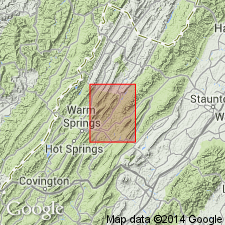
- Usage in publication:
-
- McGlone limestone
- Modifications:
-
- Named
- Dominant lithology:
-
- Limestone
- AAPG geologic province:
-
- Appalachian basin
Summary:
Named the McGlone limestone for McGlone, Monroe Co., WV. Consists of well-bedded calcilutite with variable quantities of calcilutite pebble conglomerate and laminated quartzose calcisiltite. Contains calcarenite with algal fossils at top. Thickness is 62 feet at type section and thins to the southeast. Unit overlies the Benbolt limestone and underlies the McGraw limestone with a sharp contact. The McGlone is of Middle Ordovician age.
Source: GNU records (USGS DDS-6; Reston GNULEX).

- Usage in publication:
-
- McGlone formation
- Modifications:
-
- Revised
- Redescribed
- AAPG geologic province:
-
- Appalachian basin
Summary:
Revised the McGlone to the McGlone formation in VA. Consists of olive gray, medium gray, and dark gray, aphanitic limestone that weathers light gray. The upper part was called McGraw limestone by Kay (1956) and is added to the McGlone. This upper part consists of fine-grained, gray limestone with yellow-brown argillaceous partings. The McGlone is about 50 feet thick and is of Middle Ordovician age.
Source: GNU records (USGS DDS-6; Reston GNULEX).
For more information, please contact Nancy Stamm, Geologic Names Committee Secretary.
Asterisk (*) indicates published by U.S. Geological Survey authors.
"No current usage" (†) implies that a name has been abandoned or has fallen into disuse. Former usage and, if known, replacement name given in parentheses ( ).
Slash (/) indicates name conflicts with nomenclatural guidelines (CSN, 1933; ACSN, 1961, 1970; NACSN, 1983, 2005, 2021). May be explained within brackets ([ ]).

